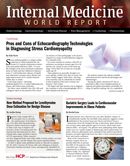Publication
Article
Internal Medicine World Report
Let's Talk Ebola: A Q&A With Ronald Nahass
Author(s):
Ronald Nahass, MD, MHCM, FACP, FIDSA, is a certified infectious disease expert in central New Jersey with the University Medical Center of Princeton at Plainsboro. He speaks with Internal Medicine World Report Editor-in-Chief, Simon Douglas Murray, MD, about several misconceptions surrounding the Ebola outbreak and provides insight to educate the readers.
Dr. Nahass, what advice could you give our readers on how to inform our patients about the hysteria associated with the Ebola outbreak? As an example, I was approached by a woman this evening who told me that she was going to Florida for a conference and she wanted to know if she should be concerned because there will be people from South Africa there as well as from other international countries. She wanted to know what she could do to protect herself from having contact with potentially infectious people.

Well first of all, there’s no risk from South Africa since there's no Ebola there. The real risk is with people who might have been care givers of patients with Ebola from West Africa, and even then has been emphasized, in the absence of symptoms, in fact pretty dramatic symptoms, it’s highly unlikely that a person going to a conference would be able to transmit the disease. If they had the stage of the disease where they were highly contagious they would be too sick to attend. It is just not passed that easily. The example I use is the case of Mr. Duncan, who everyone knows traveled from Sierra Leone to Dallas, TX, and became ill shortly after arrival with a fever of 103 plus and was turned away from a Dallas Hospital. He returned home with relatives developed diarrhea, vomiting, bleeding, and was cared for by family members who were dealing with the clothing, bed sheets and excrement and none of whom got the disease. So people have to look at that and understand the reality is that it is not easy to transmit it.
The question remains how did those nurses get it? The answer is that as the disease progressed to a level beyond what the family was exposed to, to where the viral load increases exponentially making him extremely infectious at that point. So as the disease progresses, as the severity of the illness progresses, the risk for transmission gets greater. So going to a conference you would encounter people well enough to attend would not be highly contagious even if infected.
So the risk to this woman is extremely low and she need not be concerned.
Is there value in taking temperatures at the airport, and are we doing adequate screening to keep infectious patients out of the country?
RN: I do think that the temperature taking is valid. The majority of patients with Ebola have fever, more than 90 %. In the absence of fever, the likelihood of the diagnosis is low. The fever also is an indication of the state of the disease which may be advancing and therefore might be a potential marker for those people who might have Ebola in a more advanced state. It is a good public-health policy to take people with fever out of circulation to who might have Ebola.
Even if a person treated his fever with Tylenol the chances are he would not be sick enough to transmit the disease at this stage. Is that correct?
Yes because if the person were in the more advanced form of the disease they would be in extremis with a high viral load and not just have fever as the only manifestation of the illness. Taking Tylenol might mitigate some of the symptoms of early disease but would not in any way change his contagiousness which would actually be quite low. Early in the course of Ebola patients would certainly not be out jogging like the doctor in New York City or bowling or walking around because you just can’t. The level of contagiousness has to do with stage of disease. Look at the family of Mr. Duncan who handled the patient during earlier stages and none of them got sick.
Do you think we should restrict travelers from West Africa coming into United States?
Well that is the direction we seem to be moving in, but this rapidly changing. I think just having trained public health workers that do regular medical evaluations, taking temperature twice a day and observing carefully for signs and symptoms of the illness makes a lot of sense. It is highly unlikely that anyone would be able to enter who was highly contagious.
Do you think that Ebola could be used as a terrorist weapon?
That is a question of comes up quite frequently in my lectures. If you think about it is hard to imagine. If the terrorists were sent here with Ebola they would have to be in the later stages of the disease to be highly contagious and he would not be a running around infecting masses of people. There are lots of other illnesses where a person could be contagious for a long period of time and look relatively well. An example is tuberculosis where you could infect a lot of people before you are sick. HIV is the same as well as typhoid, look at Typhoid Mary. These people are relatively asymptomatic for long periods of time while being contagious and would be a better terrorist weapon. This is pretty unlikely with Ebola because by the time you are contagious you are dying.
Like anything else, it’s fear itself of which that we need be afraid. Ebola evokes a great deal of irrational fear in society which works to the advantage of terrorists. Along those lines, while Ebola has killed several thousand people in Africa and one in the US, how many people are going to die from influenza this year?
It depends on the severity of the season but on average in the United States 35,000 people die a year from influenza, the range being 20,000-200,000. Other infectious diseases kill people as well including meningitis which kills about 1,000 people year, and many other infectious diseases will exact a far greater toll than Ebola ever will.
SM: How long can Ebola live outside the body?
There been several studies looking at this issue, the best one I think was a 2010 study by a group of virologists who tried to simulate conditions under which humans might be exposed to Ebola. They prepared Ebola solution and blood and splattered it on a variety of surfaces including hard surfaces like Formica, stainless steel, and plastic as well as wet surfaces at various temperatures. They wanted to study the viability of the virus under different environmental conditions. There are other studies but I think is the best study and reported that when Ebola is exposed to a hard surface it dries and it dies. If it in in a liquid media at room temperature a candidate for several hours. It refrigerated it can last for several days. Environmental conditions in which humans could be exposed to the virus are more likely to be hard dry surfaces such as those on a plane tray table, or on a bus. It is unlikely that a person would come across test tube of blood sitting on the seat of the bus containing Ebola. The longer the virus is exposed to air on a surface it which has the opportunity to dry, the more likely it is going to become nonviable is really related to that process. Drying is lethal to virus.
SM: Does bleach kill it?
Yes it’s killed easily by bleach and ammonia, as well as hand sanitizers containing 60-70% alcohol, which are highly effective in killing. The virus is not very hearty unlike other organisms, which can live outside the body and resistant extreme environmental conditions for long periods of time.
What is available or on the horizon for treatment or prevention?
There are a number of exciting things. ZMapp is a mixture of 3 monoclonal antibodies, grown on tobacco plants that are capable of finding 3 antigenic sites on the Ebola virus and rendering it ineffective. It was studied in 21 chimpanzees that Ebola is generally 90% fatal. Eighteen received ZMapp after developing symptoms on day 34 and all 5 survived. This is significant finding so there is a lot of hope that monoclonal antibodies will offer the opportunity for humans, because it is clear that humeral response can limit the devastation of the disease. It also appears resistance to the vaccine can be developed which will confer passive immunity to people to prevent them from getting the disease. In fact this is been done with the serum of patients who have recovered from Ebola which was given to patients who are sick from getting the deadly consequences of this disease. These people have high levels of antibodies against Ebola antigens which confer passive immunity to recipients. If you think about it this is what we do use to do with hepatitis B immunoglobulin given for needle sticks or in years past given as prophylaxis to people to protect against hepatitis A prior to travel. A vaccine raised against the correct antigen could protect a person from getting this disease, and in fact the vaccine development is ongoing and there are 3 currently in development, and I would not be surprised if trial results were not reported within the next year or so.
There is no respiratory transmission of Ebola, any food, water, or insect vectors. It is spread through direct contact with body fluids which is probably why the nurses got infections. The patient was in the late stages of disease and they handled body fluids while he was intubated. Mr. Duncan did not transmit the illness to any family members despite their contact with blood and body fluid all over the place. The patients are not highly contagious until they are in the late stages of the illness. However the risk of Ebola should not be discounted but it is not ever going to be a major problem in United States because we don’t have the same challenges and limited resources of underdeveloped countries. I think initially here, in Texas and elsewhere medical professionals and the CDC had to develop a learning curve since no one really was prepared to deal with Ebola. I do not think Dallas should be singled out for providing care that was substandard because frankly no one really had practiced for this type of illness.
.
So in reality, the Ebola crisis will come to pass and we will expect to see outbreaks occurring from time to time that we will be able to contain using good public health measures, education and some promising new medication and vaccines?
Yes I think this will happen; in fact we are starting to see that now. In Africa in Nigeria and Senegal the outbreaks from the current strain of Ebola have been contained. The Congo has a second strain of Ebola which is in the process of being contained as well. So it is clearly containable it does not have to spread widely and does not have to get out of hand.





